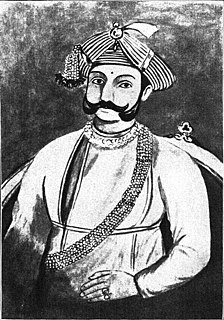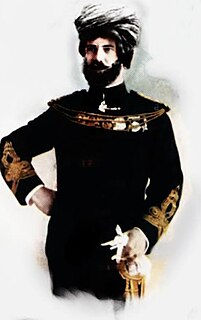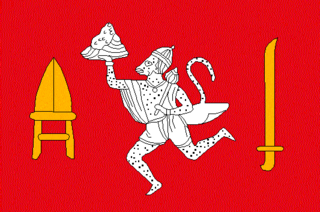
The Bangash, Bungish or Bangakh are a tribe of Pashtuns, inhabiting their traditional homeland, historically known as Bangash district, which stretches from Kohat to Tall and Spīn Ghar in Khyber Pakhtunkhwa, Pakistan. They also live as a smaller population in Paktia, Afghanistan. The Bangash are also settled in large numbers in Uttar Pradesh, India, especially in the city of Farrukhabad, which was founded in 1714 by Nawab Muhammad Khan Bangash.

The Tirah also spelled Terah also called the Tirah Valley, is a mountainous tract located in the Khyber district, lying between the Khyber Pass and the Khanki Valley in Pakistan.

Bhopal State was an Islamic principality founded in the beginning of 18th-century India by the Afghan Mughal noble Dost Muhammad Khan. It was a tributary state during 18th century, a princely salute state with 19-gun salute in a subsidiary alliance with British India from 1818 to 1947, and an independent state from 1947 to 1949. Islamnagar was founded and served as the State's first capital, which was later shifted to the city of Bhopal.

Pilajirao Gaekwad was a Maratha general. He is considered to be the founder of the Gaekwad dynasty of the Maratha Empire, who became Maharaja of Baroda.

The provinces of India, earlier presidencies of British India and still earlier, presidency towns, were the administrative divisions of British governance on the Indian subcontinent. Collectively, they have been called British India. In one form or another, they existed between 1612 and 1947, conventionally divided into three historical periods:

The Central Provinces was a province of British India. It comprised British conquests from the Mughals and Marathas in central India, and covered parts of present-day Madhya Pradesh, Chhattisgarh and Maharashtra states. Its capital was Nagpur. Its Summer Capital was Pachmarhi. It became the Central Provinces and Berar in 1903.
Bāyazīd Khān Ansārī Pīr Rōshān or Pīr Rōkhān (1525–1585) was an Afghan warrior, poet, Sufi, and revolutionary leader. He wrote mostly in Pashto, but also in Persian, Hindustani, and Arabic, while he also spoke Ormuri. He is known for founding the Roshani movement, which gained many followers in the Pashtunistan region and produced numerous Pashto poets and writers.

Pathari State was established by the Nawabzada Hayder Mohammad Khan of Orakzai Clan Mirazikhel tribe. The State of Bhopal and Rahatgarh later Rahatgarh state become Pathari after losing rule over Rahatgarh by East India Company was founded in 1723 by Sardar Dost Muhammad Khan, from Tirah in Afghanistan, a descendant of the Mirazi Khel branch of the Warakzais (Orakzai) Pathans. He entered the service of Emperor Aurangzeb and had been appointed Governor of Bhairsa. Taking advantage of the disintegrating of the Mughal Empire, he declared his independence and found a separate state. Bhopal and Rahatgarh divided between two sons of Nawab Dost Mohammad Khan Nawab Yar Mohammad Khan got reign over Bhopal State and Nawab Sultan Mohammad Khan over Rahatgarh later became Pathari State
The Orakzai are a Pashtun tribe native to the Orakzai Agency and parts of Kurram Agency located in the Khyber Pakhtunkhwa province of Pakistan. They speak the language Pashto.

The Imperial Gazetteer of India was a gazetteer of the British Indian Empire, and is now a historical reference work. It was first published in 1881. Sir William Wilson Hunter made the original plans of the book, starting in 1869.

Nawab Sir Muhammad Akram Khan was the ruler of the Indian princely state of Amb from 1877 until his death in 1907. Son of Jehandad Khan, he was only nine years old when his father died. People of that time thought that Maddad Khan Tanoli, the ruling Khan of Phulra, might assert a claim as ruler but no such event occurred at that time.

Narsinghgarh State is a former princely state of the British Raj in India. It formed an enclave within Rajgarh State and was placed administratively under the Bhopal Agency subdivision of the Central India Agency. The state covered an area of 1,920 square kilometres (740 sq mi) and had a population of 92,093 and an average revenue of Rs.5,00,000 in 1901.
Bolundra is a village, princely state and Taluka in Modasa, India. The village is in Aravalli district in Gujarat state, western India, on the bank of the River Meshvo.

The State of Shahpura or Princely State of Shahpura was a princely state in Shahpura, Bhilwara during the era of British India. Its relations with the British were managed by the Rajputana Agency. The last ruler of Shahpura signed the accession to join the Indian Union in 1949.

Basoda State was a former princely state in Central India, part of the Bhopal Agency during the British Raj with the capital at Haidergarh. It was also known as Nawab-Basoda or Haidargarh-Basoda in order to distinguish it from a place with the same name in Gwalior State.

Pathari is a town in Vidisha district, Many tourist attractions in the Indian state of Madhya Pradesh.

Farrukhnagar railway station is a small railway station in Gurugram district, Haryana. Its code is FN. It serves Farrukhnagar city. The station consists of one platform. The platform is not well sheltered. It lacks many facilities including water and sanitation.
Maddad Khan Tanoli was the younger brother of Mir Painda Khan. He played a considerable part in fighting the Sikh Empire with his brother Painda Khan. His brother Painda Khan gifted him land as Jagirdar.
MirNawab Khan Tanoli was the ruler of The Tanawal valley and the Chief of the Hazara region from circa 1810 until he died in 1818. During his rule, he faced many attacks from the Sikh Empire and Durrani Empire, resulting in a significant loss of territory. He was 26 years old, when he was assassinated by Azim Khan on October 13, 1818 in the Stratagem of Peshawar.













